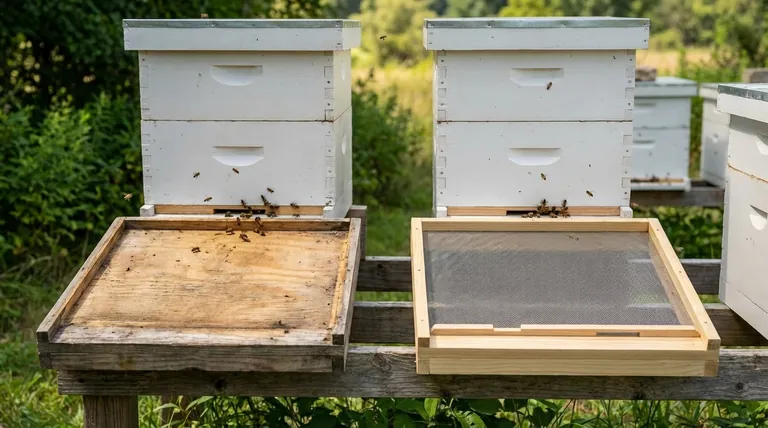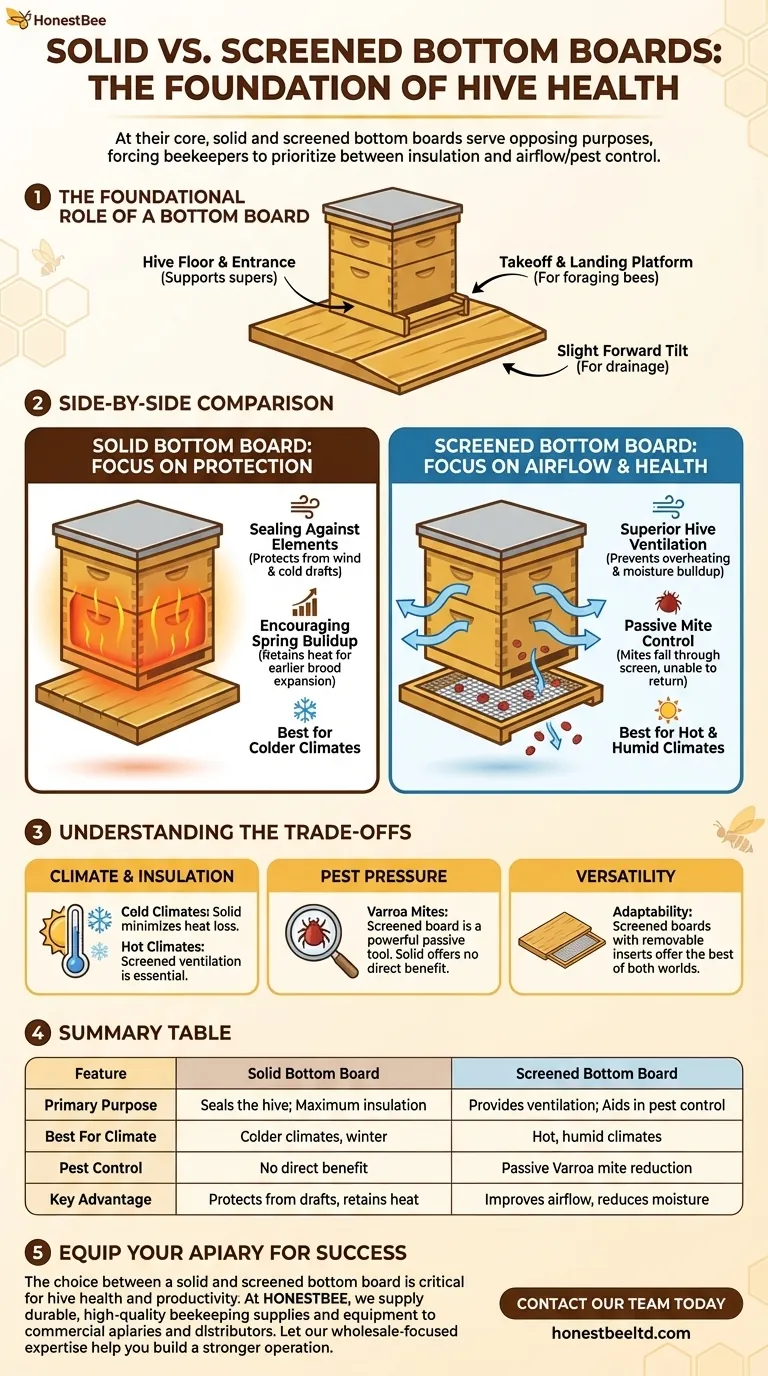At their core, solid and screened bottom boards serve opposing purposes. A solid bottom board is designed to completely seal the base of the beehive, offering maximum protection from the elements. In contrast, a screened bottom board is designed to provide maximum ventilation and assist in non-chemical pest management.
The decision between a solid or screened bottom board is a fundamental choice in beekeeping, forcing you to prioritize between the benefits of insulation (solid) versus the advantages of airflow and passive mite control (screened).

The Foundational Role of a Bottom Board
Before comparing the two types, it's important to understand the universal function of any bottom board. It is the literal foundation of the entire hive structure.
The Hive's Floor and Entrance
A bottom board serves as the floor for the colony, supporting the weight of all the hive bodies (supers) stacked above it. It also creates the primary entrance and exit for the bees.
A Takeoff and Landing Platform
This base acts as a crucial platform for foraging bees. For optimal drainage, the entire hive should be tilted slightly forward, ensuring rainwater doesn't run inside.
The Solid Bottom Board: A Focus on Protection
A solid bottom board is the traditional, classic design. Its primary purpose is to create an insulated, sealed floor for the hive.
Sealing Against the Elements
The main advantage of a solid board is its ability to protect the colony from wind and cold drafts coming from below. This is particularly valuable in colder climates or during winter.
Encouraging Spring Buildup
By retaining more heat within the hive, a solid bottom board can contribute to an earlier and more rapid expansion of the brood nest in the spring. A warmer cluster can dedicate more energy to raising young bees.
The Screened Bottom Board: A Focus on Airflow and Health
The screened bottom board (or Integrated Pest Management board) is a more modern design that prioritizes hive health through ventilation and pest control.
Superior Hive Ventilation
The screen allows for constant air circulation, which is critical in hot and humid climates. This ventilation helps prevent the hive from overheating and reduces moisture buildup, which can lead to mold and other issues.
A Passive Tool for Mite Control
One of the most significant benefits is its role in managing Varroa mites. As mites naturally fall off bees, many will drop through the screen and out of the hive, unable to climb back in. This provides a constant, non-chemical method for reducing the mite population.
Understanding the Trade-offs
Neither option is universally superior; the right choice depends entirely on your goals, methods, and local environment.
Climate and Insulation
In very cold climates, some beekeepers prefer solid bottom boards to minimize heat loss during the harsh winter months. Conversely, in hot climates, the ventilation from a screened board is almost essential to prevent the colony from overheating.
Pest Pressure
If your primary concern is managing Varroa mites with as few chemical interventions as possible, the screened bottom board is a powerful tool in your arsenal. The solid board offers no such advantage.
Versatility
Many modern screened bottom boards come with a removable solid insert (often called a "debris board" or "sticky board"). This offers the best of both worlds: you can keep the insert in during cold winters for insulation and remove it during the summer for ventilation and mite drops.
Making the Right Choice for Your Apiary
Your decision should be a conscious one based on your specific beekeeping philosophy and environment.
- If your primary focus is maximum insulation for cold winters: The classic solid bottom board provides the most protection from cold drafts from below.
- If your primary focus is hive health in a warm climate or passive mite control: The screened bottom board is the superior choice for ventilation and reducing Varroa numbers.
- If your primary focus is adaptability throughout the seasons: A screened bottom board with a removable insert provides the most flexibility, allowing you to tailor the hive to changing conditions.
Choosing the right foundation for your hive is a key step in proactive and successful beekeeping.
Summary Table:
| Feature | Solid Bottom Board | Screened Bottom Board |
|---|---|---|
| Primary Purpose | Seals the hive; Maximum insulation | Provides ventilation; Aids in pest control |
| Best For Climate | Colder climates, winter | Hot, humid climates |
| Pest Control | No direct benefit | Passive Varroa mite reduction |
| Key Advantage | Protects from drafts, retains heat | Improves airflow, reduces moisture |
Equip your apiary with the right foundation for success. The choice between a solid and screened bottom board is critical for hive health and productivity. At HONESTBEE, we supply durable, high-quality beekeeping supplies and equipment to commercial apiaries and distributors. Let our wholesale-focused expertise help you build a stronger, healthier operation. Contact our team today to discuss your specific needs and optimize your hive management.
Visual Guide

Related Products
- Langstroth Screen Bottom Board for Beekeeping Wholesale
- Australian Pine Wood Langstroth Screen Bottom Board for Wholesale
- HONESTBEE Wooden Bee Escape Board with Triangle Mesh Design for Beekeeping
- HONESTBEE Professional Frame Wiring Board and Jig
- HONESTBEE Durable Frame Wiring Board with Integrated Tensioner
People Also Ask
- What are the main benefits of using a Screened Bottom Board in beekeeping? Enhance Hive Health & Productivity
- What are some considerations when choosing between solid and screened bottom boards? Optimize Hive Health & Pest Control
- What are the advantages of a screened bottom board? Boost Hive Health with Superior Ventilation & Pest Control
- What are the benefits of using a screened bottom board in warm or humid climates? Boost Hive Health & Control Pests
- What is the primary function of a screened bottom board in a hive? Enhance Ventilation & Control Varroa Mites



















